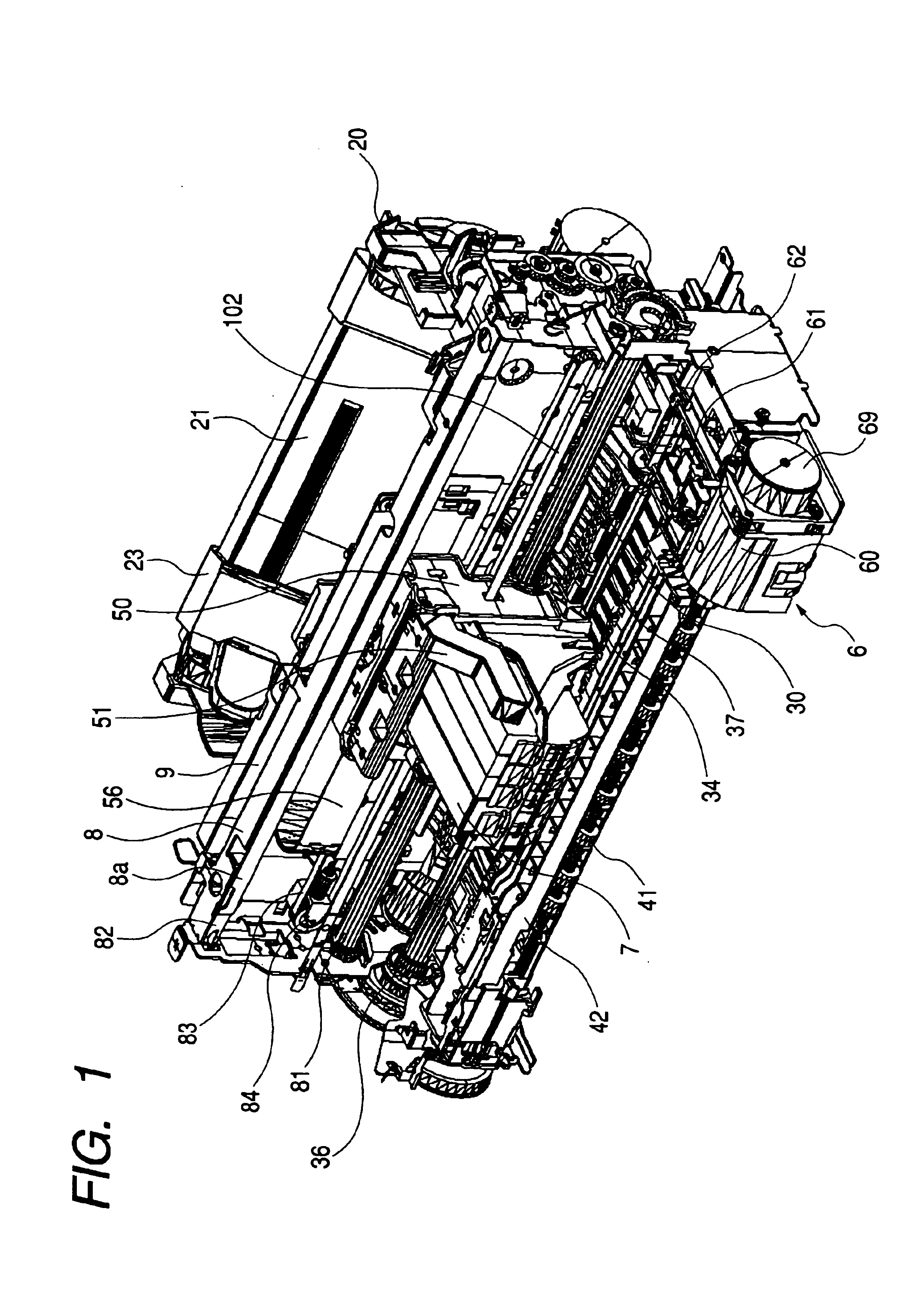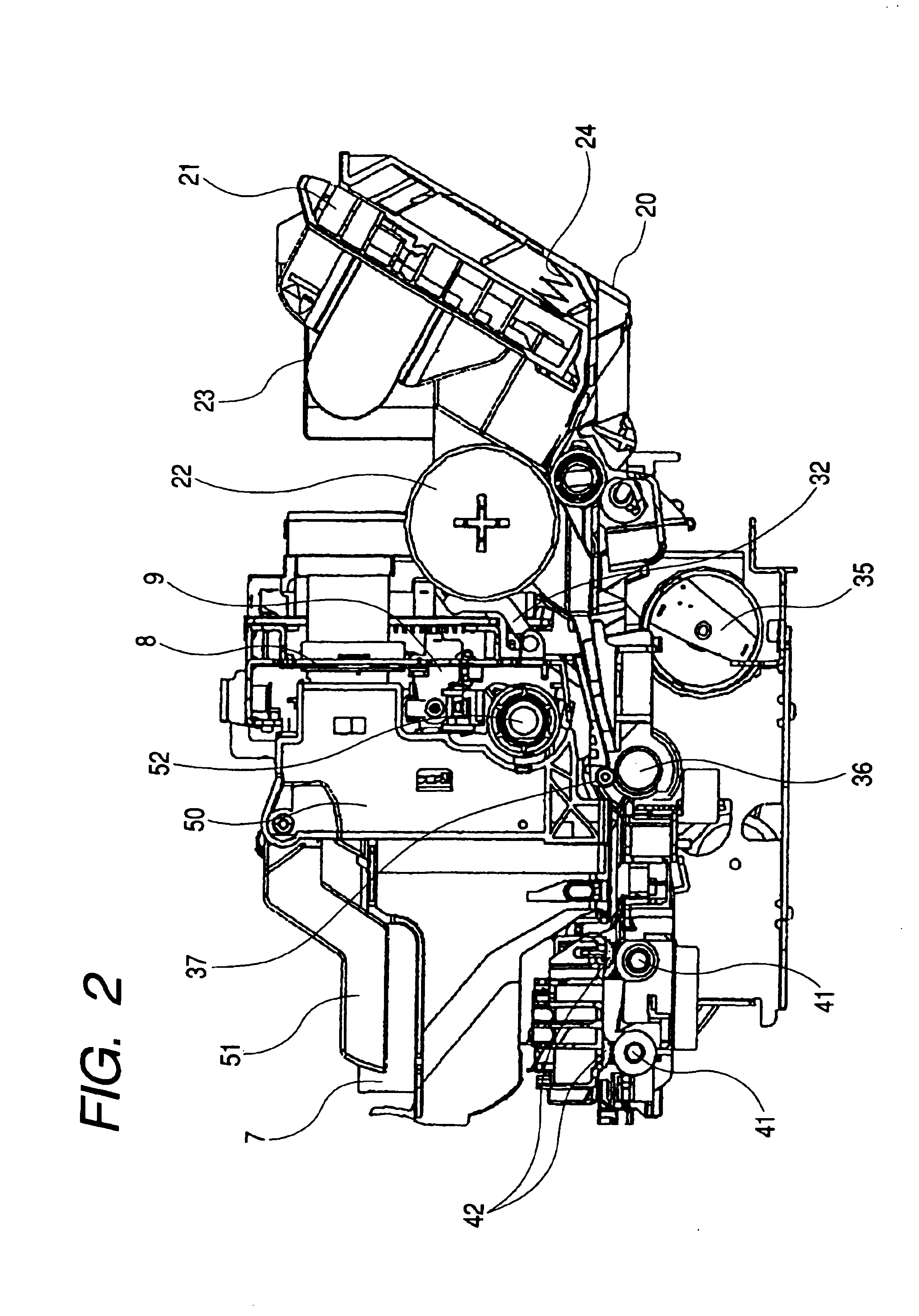Recording apparatus
- Summary
- Abstract
- Description
- Claims
- Application Information
AI Technical Summary
Benefits of technology
Problems solved by technology
Method used
Image
Examples
first embodiment
(First Embodiment)
[0033]The structure of the recording apparatus of the present invention is first schematically shown in FIGS. 1 and 2. FIG. 1 is a perspective view showing the general construction of a recording apparatus according to an embodiment suitable for the present invention, and FIG. 2 is a side cross-sectional view of the recording apparatus.
[0034]The recording apparatus 1 of the form shown in FIG. 1 is an ink jet recording apparatus of a serial scan type, and comprises a sheet feeding portion having an automatic feeder, a sheet conveying portion, a sheet discharging portion, a carriage portion 5 and a cleaning portion 6. These will be divided into items and will be schematically described in succession. Also, while in the present embodiment, description will be made with the ink jet recording apparatus taken as an example, the present invention is not restricted to the ink jet recording type, but can be applied to any recording apparatus of the serial scan type. Also, w...
second embodiment
(Second Embodiment)
[0052]A second embodiment of the present invention will now be described with respect to its difference from the first embodiment.
[0053]FIG. 5 shows that portion of a carriage portion in the second embodiment of the present invention, which is concerned in drive transmission. However, FIG. 5 represents only the projected portion 50a of the carriage 50 and the belt holder 59 shown in FIGS. 3 and 4, and does not show the damper 71 and the timing belt 83.
[0054]In the present embodiment, as shown in FIG. 5, the design gap “d” between the projected portion 50a of the carriage 50 and the belt holder 59 in the scanning direction of the carriage is made smaller than the thickness “t” of the damper 71. According to the present embodiment, there is realized such a dimensional relation that the damper 71 is compressed in advance, and the oscillation of the carriage with respect to the scanning direction of the carriage can be suppressed more effectively.
third embodiment
(Third Embodiment)
[0055]A third embodiment of the present invention will now be described with respect to its differences from the first embodiment.
[0056]FIG. 6 shows a portion of a carriage portion in the third embodiment of the present invention, which portion is concerned in drive transmission. Hatchings in FIG. 6 represent a cross-section.
[0057]As described in the first embodiment, in the connecting structure for the carriage portion and the timing belt, the driving force from the carriage motor is transmitted to the belt holder 59 through the timing belt 83, and is further transmitted from the belt holder 59 to the damper 71 and the carriage 50. In this form, a force, which rotates the belt holder 59, is applied during the start.
[0058]As a countermeasure for this, as shown inFIG. 6, convex portions 50c are provided at two locations along the scanning direction of the carriage on each of two upper and lower sides of the projected portion 50a of the carriage 50, which convex port...
PUM
 Login to View More
Login to View More Abstract
Description
Claims
Application Information
 Login to View More
Login to View More - R&D
- Intellectual Property
- Life Sciences
- Materials
- Tech Scout
- Unparalleled Data Quality
- Higher Quality Content
- 60% Fewer Hallucinations
Browse by: Latest US Patents, China's latest patents, Technical Efficacy Thesaurus, Application Domain, Technology Topic, Popular Technical Reports.
© 2025 PatSnap. All rights reserved.Legal|Privacy policy|Modern Slavery Act Transparency Statement|Sitemap|About US| Contact US: help@patsnap.com



